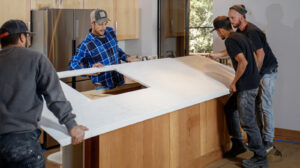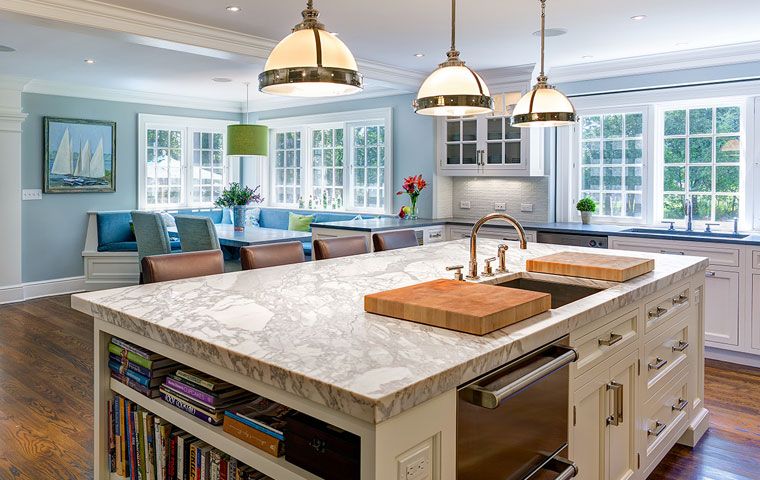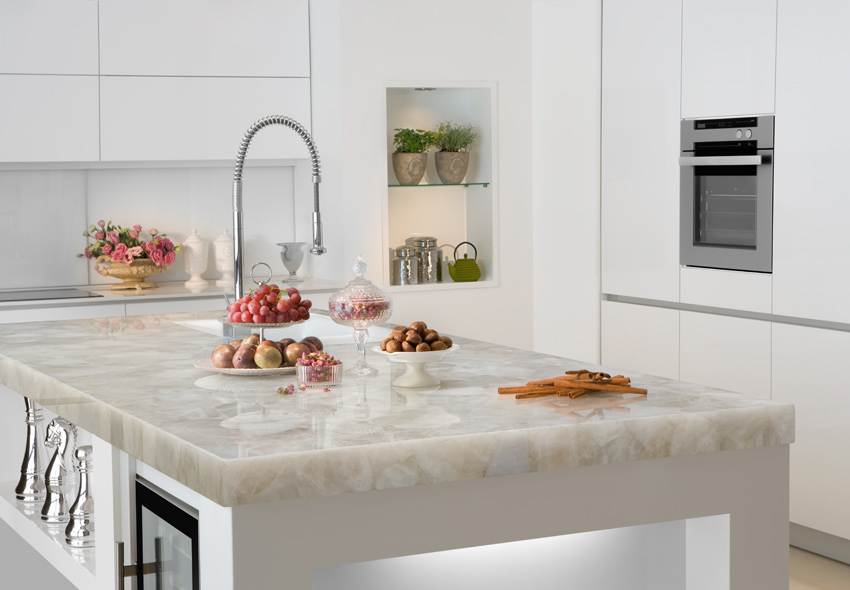Table of Contents
- Are Quartz Countertops Man-Made?
- What Are Quartz Countertops Made Of?
- How Are Quartz Countertops Manufactured?
- Crush Natural Quartz into Fine Particles
- Blend Quartz with Resin & Color Pigments
- Pour the Mixture into a Slab Mold
- Remove Air with Vacuum & Vibration
- Press the Slab with Extreme Force
- Cure in an Industrial Oven
- Cool and Harden the Slab
- Trim Edges & Level Surface
- Polish or Texture the Face
- Inspect, Label, & Ship to Fabricators
- Engineered Quartz vs. Natural Stone
- Top Benefits of Engineered Quartz in 2025
- Environmental & Health Considerations
- Care & Maintenance Best Practices
- Frequently Asked Questions
- Key Takeaways
Are Quartz Countertops Man-Made?
Short answer: Yes—quartz countertops are engineered surfaces manufactured in a factory. Invented in Italy during the 1960s under the Bretonstone® patent, the process turns crushed quartz crystals into dense, non-porous slabs that look like natural stone yet deliver consistent performance in the kitchen and bath. Nearly every major brand (Caesarstone, Silestone, MSI, Cambria, and others) still licenses variations of this technology today.
Why does the “man-made” element matter? Precision manufacturing eliminates the hidden fissures and mineral deposits common in quarried granite or marble, giving homeowners dependable color, pattern, and structural integrity across every project.
What Are Quartz Countertops Made Of?
| Ingredient | Typical Share by Weight | Role in the Slab |
| Natural quartz crystals | 90 – 93 % | Core hardness, scratch resistance |
| Polyester or epoxy resin | 7 – 10 % | Binds particles, adds flexural strength |
| Pigments & mineral dyes | < 1 % | Creates whites, blacks, veined marble looks, or concrete tones |
| Optional additives | Trace | Recycled glass chips, mirror flecks, antimicrobial agents |
Quartz (Mohs 7) is harder than steel wool, giving the countertop formidable scratch resistance. Resins fill microscopic gaps, blocking stains and eliminating the need for routine sealing.
How Are Quartz Countertops Manufactured?
Below is the 10-step factory roadmap that turns loose quartz granules into a showroom-ready countertop:
1. Crush Natural Quartz into Fine Particles
Mined quartz is sorted by size, then crushed and sieved into a spectrum ranging from powder to 6 mm grains.
2. Blend Quartz with Resin & Color Pigments
Computer-controlled hoppers weigh each component precisely. Pigments determine final hue; titanium dioxide produces crisp whites, while iron oxide creates rich charcoal tones.
3. Pour the Mixture into a Slab Mold
The blended “slurry” is poured into a steel mold roughly 10 feet long and 5 feet wide—the starting dimensions of most slabs.
4. Remove Air with Vacuum & Vibration
Heavy vibration plus vacuum pumps evacuate air pockets, ensuring full density and preventing internal weak points.
5. Press the Slab with Extreme Force
A hydraulic press exerts ~100 tons of force, locking particles into a compact matrix harder than many natural stones.
6. Cure in an Industrial Oven
Slabs enter a kiln (about 85 °C) for 30–45 minutes. Heat polymerizes the resin, permanently bonding the crystals.
7. Cool and Harden the Slab
Controlled cooling prevents thermal shock and preserves dimensional stability.
8. Trim Edges & Level Surface
Diamond-tipped saws square the perimeter; a calibrating grinder brings thickness to an exact 2 cm or 3 cm.
9. Polish or Texture the Face
Automatic polishers run the surface under successive diamond pads, creating glossy, matte, suede, or leathered finishes on demand.
10. Inspect, Label, & Ship to Fabricators
Technicians check for color match, thickness tolerance, and surface defects before the slab leaves the plant. Only A-grade pieces reach distributors.
From raw mineral to finished slab, the entire cycle can finish in under two hours, light-years faster than eons of geologic pressure.
Engineered Quartz vs. Natural Stone
| Feature | Quartz (Engineered) | Granite | Marble |
| Porosity | Non-porous (no sealing) | Micro-porous; requires annual sealing | Highly porous; etches easily |
| Pattern Consistency | Uniform from slab to slab | Unique per block | Dramatic veining varies widely |
| Scratch Resistance | 7 Mohs | 6–7 Mohs | 3–4 Mohs |
| Heat Resistance | Up to ~150 °C (use trivets) | Up to ~300 °C | Sensitive to thermal shock |
| Maintenance | Soap-and-water clean-up | Needs sealer + neutral cleaner | Sealer + pH-neutral soap |
| Average Installed Cost* | $80–$120 / sq ft | $60–$130 / sq ft | $90–$160 / sq ft |
| Sustainable Options | Recycled quartz lines | Heavy quarry impact | Quarry + chemical sealers |
*Pricing reflects U.S. averages as of Q1 2025.
Top Benefits of Engineered Quartz in 2025
- Stain Shield: Non-porous chemistry shrugs off coffee, wine, and cooking oil without sealing.
- Design Freedom: Hundreds of patterns now mimic exotic marbles (Calacatta Laza Oro, etc.) or sleek industrial concretes.
- Low Upkeep: Simple dish soap handles daily mess; no annual maintenance schedule to remember.
- Structural Stability: Manufactured density reduces the risk of hidden cracks during transport or installation.
- Eco-Friendly Lines: Several brands incorporate up to 40 % recycled content, cutting virgin mining demand.
- Resale Appeal: Real estate agents note that quartz kitchens often photograph better and signal “move-in ready” to buyers.
- Wide Slab Sizes: Jumbo slabs (63″ × 138″) minimize seams on large islands.
Environmental & Health Considerations
- Silica Exposure During Fabrication
Cutting or polishing quartz releases fine silica dust. Poor shop ventilation can cause silicosis, a progressive lung disease that has triggered new UK safety proposals and an Australian ban on high-silica engineered stone. End users face no risk once the slab is installed, but choose fabricators who follow wet-cutting protocols and respirator standards. - Certifications to Look For
- GREENGUARD Gold: Verifies low VOC emissions.
- NSF 51: Confirms food-safe surfaces.
- Declare Labels / HPDs: Reveal chemistry for green-building credits.
- GREENGUARD Gold: Verifies low VOC emissions.
- Recycling & End-of-Life
Although quartz can’t yet be “remelted,” some demolition contractors crush off-cuts into landscaping aggregate, reducing landfill waste.
Care & Maintenance Best Practices
| Task | Frequency | How-to |
| Routine wipe-down | Daily | Mild dish soap + microfiber cloth |
| Deep degrease | Weekly | pH-neutral spray; avoid bleach or oven cleaners |
| Heat protection | Always | Use trivets for cookware > 150 °C |
| Cutting tasks | Always | Boards protect both countertop and knife edges |
| Tough residue | As needed | Plastic scraper + isopropyl alcohol |
Avoid abrasive pads (steel wool) and harsh chemicals (paint stripper, drain cleaner). Their alkalinity can dull resin binders.
Frequently Asked Questions
Is engineered quartz completely synthetic?
No. About 90 % of each slab is natural quartz crystal; only the remaining binder system is synthetic.
Can quartz be used outdoors?
Standard slabs may yellow under UV exposure. Choose UV-stable variants marketed for exterior use if the countertop will face direct sunlight.
Does quartz handle hot pans?
Brief contact with a 150 °C pot is usually safe, but prolonged heat can scorch resin. Always deploy trivets.What edge profiles work best?
Eased, beveled, and mitered waterfall edges all perform well. Intricate ogee edges are possible but raise fabrication costs.


